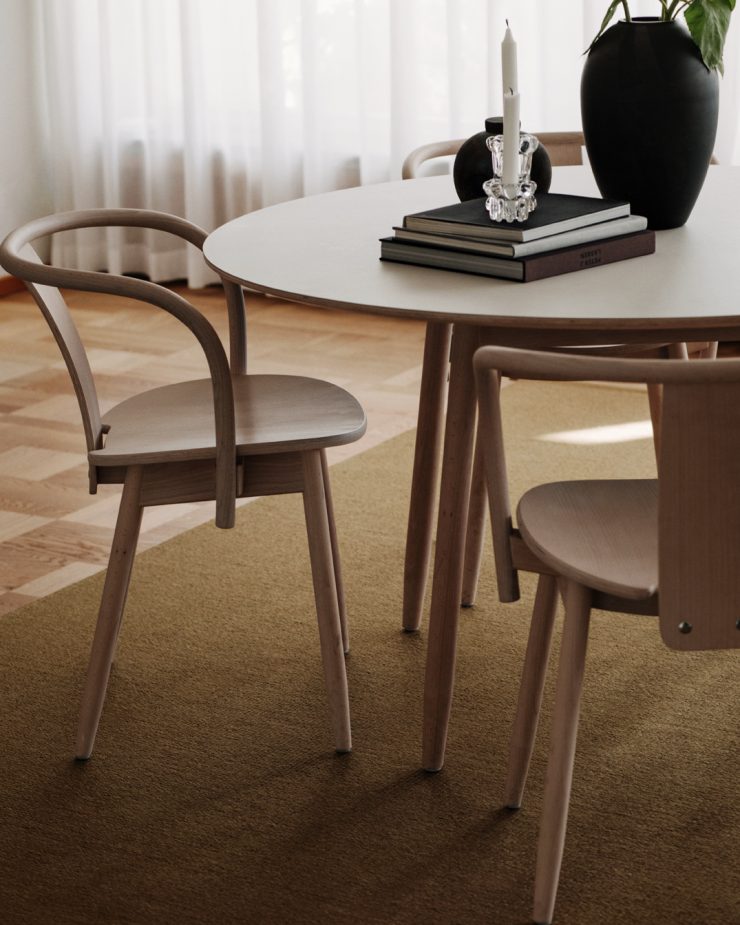CARE AND MAINTENANCE
This document presents information on how to treat and take care of your Massproductions products, so that they can be used and loved for a longer period.
For environmental, as well as material reasons, Massproductions encourages cleaning without chemical detergents wherever possible, for example by using a dust cloth or a slightly damp cloth. For more specific advice for care of different materials, see the sections below.

This document presents information on how to treat and take care of your Massproductions products, so that they can be used and loved for a longer period.
For environmental, as well as material reasons, Massproductions encourages cleaning without chemical detergents wherever possible, for example by using a dust cloth or a slightly damp cloth. For more specific advice for care of different materials, see the sections below.
Textile/fabric:
Massproductions encourages our customers to vacuum their upholstered products on a regular basis, with a soft nozzle, to reduce wear-and tear on fabrics and padding caused by dust and dirt.
Stains on the fabric should be removed as quickly as possible. Soak the stain gently, by dotting it from the edges into the center with a damp white cloth and distilled water. Note that you should not rub the stain. For tougher stains we recommend using a pH-neutral detergent or a detergent for professional use. Stain removers should only be used after they first have been tested on a small, non-visible, part of the fabric. Remember to only use white cloth to reduce the risk of color transfer.
In case that the covers need to be washed, it’s recommended that they are dry-cleaned, even if the fabric manufacturer states that the fabric can be washed in some other way. If in doubt, please contact Massproductions for consultation. Avoid soaking of woolen fabrics if it is possible due to the risk of shrinking.
Some fabrics are more resistant to light than others, but eventually all fabrics will be affected by both sunlight and artificial light. If the product is to be placed in a bright environment, the fabric’s light fastness (resistance to, among other things, discoloration) should be taken into consideration. Dark fabrics are more often more sensitive to both artificial light and sunlight than light colors.
All fabrics will stretch over time through use, and this may cause wrinkles or a “softer” look of the product. This is a natural consequence of use and has nothing to do with the quality or durability of the fabric. Some materials, such as linen, are more prone to wrinkles, while knitted fabrics are less prone. Please contact Massproductions if you require advice on choosing a fabric that suits your needs.
Pile in fabrics can be pushed down and appear as so called “mirrors” when exposed to weight of some kind. This is to be considered as a natural consequence of use and has nothing to do with the durability of the fabric. The pile can in some cases be lifted by rubbing the fabric gently in the opposite direction of the pile.
Fabrics containing polyester may in some cases form nubs in contact with other soft fabrics, such as plaids, sweatpants or similar. This is seen as a natural characteristic of the fabric, and the nubs can easily be removed with a pilling machine.
When washing a product with Velcro, it’s recommended that a protective plain weave, or a thin, soft Velcro, is placed on the hard Velcro to prevent it from destroying the fabric in the wash.
Leather:
Furniture with leather should be protected from direct sunlight and other sources of heat, such as radiators, stoves or fireplaces. This is to avoid discoloration, drying and in worst cases cracking of the leather.
Furniture with leather should be cleaned with a dry soft cloth, and if needed additional cleaning could be made for specific areas. If the product is vacuumed, Massproductions urge to use a very soft nozzle and a “delicate hand”, to avoid scratching of the leather. To remove water-soluble stains, dab the stain with water by using a white clean cloth, and then soak up the water with a new clean and dry white cloth or kitchen towels. In need of stronger detergents, use water-based leather care products.
Certain types of leather need to be treated with leather cream or leather oil on a regular basis. However, if the leather is damaged these products might change the color of the product. Please note that the leather might become slightly darker for a while when treated, and this is a natural feature of the material and the treatment.
Leather stretches over time, and this might result in wrinkles or a looser cover of the furniture. This is a natural consequence of use and has nothing to do with the quality or durability of the leather.
Always follow the instructions given by the leather manufacturer. For more information on this, please contact Massproductions.
Wood:
Wood is a vivid, living material, with natural variations depending on the life of the tree. The material can vary in structure, color and patterns, both within a log as well as between products and samples.
In some cases, the character of the material might be affected by sunlight or artificial light. Because of this, objects which are placed on the furniture, and not moved over a period of time, can result in permanent color and brightness changes of the surface. Wooden furniture is extra sensitive for light exposure in the beginning of use, and therefore should extra care be taken regarding permanent placement of objects during this time.
The durability of your wooden furniture depends on how the surface is treated, where oiled and stained surfaces are more sensitive than for example painted, lacquered or laminated surfaces, and on the hardness of the wooden material. The surface is sensitive to, among other things, mechanical damage, sharp objects, and some chemical solvents and detergents. Wooden furniture should always be protected against warm, moist, damp, or colored objects. Spills on the wood must be removed as quickly as possible. Light wooden materials or treatments are more sensitive to stains, from for example coffee, red wine or soda, than dark wooden materials or treatments.
For a daily cleaning, use a damp white cloth without detergents. For more thorough cleaning, use a mild pH neutral detergent and lukewarm water in a well wrung cloth. Then wipe off with clean water and wipe dry. Products with a water-based lacquer or stain should not be cleaned with alkaline- or other aggressive cleaning agents. Note that the product should not be left wet or damp since water can penetrate the surface and damage the furniture.
Wooden furniture with oiled surfaces should be well oiled before first use. The product should then regularly, two to three times per year, or when needed, be treated with oil for wooden furniture. Before oiling, the product should be cleaned with special wooden detergent. Note that an oiled product should not be placed directly on a rug, towards a wall, or be covered with a tablecloth, directly after that it has been oiled due to risk of staining.
Wooden furniture that is placed in a humid environment may in time attract moisture from the air, which can result in color changes, bumps, bending, or cracks. Changes in the wood can also occur if furniture intended for indoor use is placed outdoors.
To make your wooden furniture last as long as possible, we recommend that you check screws and fittings on a regular basis, and tighten them if necessary.
Polyether:
After a period of time, products made out of polyether might deform slightly if always used in the same way, for example, if you always sit in the same place on a sofa. It’s recommended that products made from polyether are “nudged” once a week to keep the shape.
Due to the characteristics of the material, the polyether will also become softer over time. This is considered a natural consequence of use and has nothing to do with the quality of the material or the product.
Down:
Pillows filled with down, or with a combination of down and other materials, generally require some maintenance. The down can be compressed when the products is used, and it is therefore important to “nudge” the cushions by removing them and hitting them gently with open palms a couple of times a week.
It’s not recommended that the pillows are vacuumed without a cover if they contain down, since this might result in that quills are pulled out of the product.
Marble:
Marble is a porous material and is therefore sensitive if it’s untreated. Acids such as citrus fruits, wine and coffee might leave permanent color- and or structural changes in the surface. Since stone plates come from a natural source, each product will differ in color and/or pattern. This is a natural feature of the material.
For daily cleaning, use a clean cloth moistened with water. Avoid the use of detergents since it might leave a greasy coating that removes the stone’s glossy surface over time. Do not use chemical acidic solutions, or chemicals containing salt, as this can damage the surface.
Please note that marble is sensitive during transport or movement and can be chipped or broken if dropped or handled without care.
Concrete:
Natural materials, such as concrete and stone, are sensitive to staining and therefore it’s important to remove material and/or liquids that has been spilled on to the product as soon as possible. The material is especially sensitive to acids, and if acid spills are not handled urgently there is a risk for the material to erode.
For cleaning use a detergent, or mild pH neutral detergent and lukewarm water in a well wrung cloth. Then wipe off with clean water and wipe dry. To preserve the look and finish you should be careful not to use alkaline or aggressive cleaners, solvent preparations containing abrasives or abrasive tools. Note that the detergents used should not contain any acids. Remember not to leave cleaners or other liquids on the surface for long.
Metal:
Metal is a robust material, and it is often the surface treatment which is the most sensitive part of the component. The metal details should therefore be cleaned with a damp white cloth and a mild detergent. Note that the material might be scratched by alkaline or aggressive cleaners, solvent preparations containing abrasives, or abrasive tools.
Caution is recommended when cleaning around the furniture, since repeated contact from, for example, vacuum cleaners, might result in scratches or other damages.
Glass:
Glass is a material with a very characteristic appearance and qualities. The surface is generally robust, but it can be damaged by sharp objects, excessive heat, or frozen items. Surfaces of glass should always be handled with care when installing or moving. Collisions or forces from the side are especially damaging.
Glass products should be cleaned with glass cleaner and a soft white cloth.
Protect your floor:
Massproductions recommends that you put felt feet, or similar, under the legs of your furniture to protect the floor. For products with wheels, it’s recommended to use small plastic cups to keep the wheels in place.

